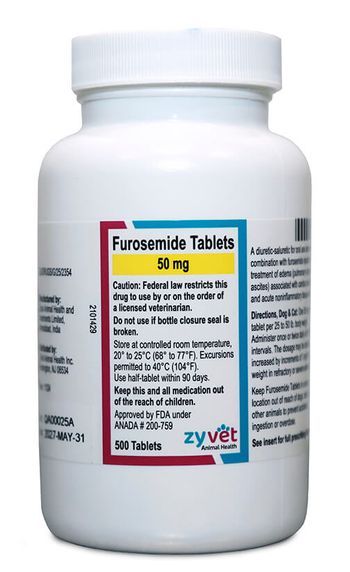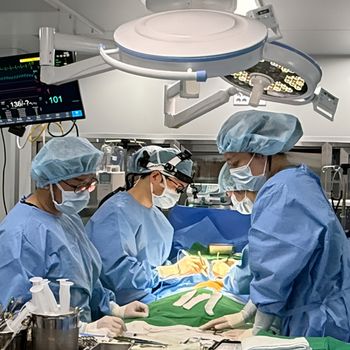
Managing feline cardiomyopathies (Proceedings)
Myocardial disease is the most frequently diagnosed type of heart disease in the cat.
Etiology and epidemiology
Myocardial disease is the most frequently diagnosed type of heart disease in the cat. Until recently, the two most common forms of cardiomyopathy in the cat were idiopathic dilated cardiomyopathy (DCM) and hypertrophic cardiomyopathy (HCM). The discovery in 1987 that most cases of DCM in cats resulted from inadequate amounts of available dietary taurine caused most cat food manufacturers to increase the taurine content in their cat diets. Since then, the prevalence of DCM in cats has drastically declined.
In the past, all cats with concentrically hypertrophied ventricles were considered to have HCM. It is now obvious that many of these cats suffer from hyperthyroidism or from systemic hypertension, and that their myocardial disease is secondary to these conditions. The term hypertrophic cardiomyopathy should be reserved for those patients with idiopathic left ventricular hypertrophy. Cats with HCM may range from one to 16 years of age, with a large percentage ranging from 4 to 7 years. Neutered male cats were found to be at increased risk for HCM compared to neutered female cats, but significant breed predilections are more difficult to identify. A colony of Maine Coon cats has been identified that display a severe and rapidly progressive form of HCM. A genetic alteration in cardiac myosin binding protein C (single base pair change from G to C) has been identified as a cause of familial HCM in some Maine Coon cats. This base pair change alters the protein confirmation and results in sarcomeric disorganization. Similarly an alteration in cardiac myosin binding protein C (base pair change A to T) has been found in Ragdolls with familial hypertrophic cardiomyopathy. There are over 200 genetic alterations that have been identified in humans with familial HCM, therefore it is likely there are many additional genetic modifications responsible for feline HCM.
History and clinical signs
Labored respiration (tachypnea, open-mouthed breathing) is the most common owner complaint, developing either as a consequence of pleural effusion or pulmonary edema. Other common clinical signs include lethargy and anorexia. Some cats present for sudden paralysis, usually of the hindleg, due to arterial thromboembolism. Syncope and sudden death are uncommon signs and are most frequent in cats with HCM. Sudden death is likely the consequence of terminal ventricular arrhythmias that have developed subsequent to myocardial ischemia.
Physical examination
Systolic murmurs are common in all types of feline cardiomyopathy. They usually result from systolic anterior motion of the mitral valve/mitral insufficiency or from dynamic right ventricular outflow tract obstruction. Audible disturbances of rhythm and pulse deficits are also common. Gallop heart sounds are audible in most cases where ventricular gallops, S3 sounds, are most common in DCM and atrial gallops, S4 sounds, are more common in HCM. Rapid heart rates make precise identification of these sounds impossible by auscultation and difficult by phonocardiography. Summation gallops may also be auscultated. Rales, dyspnea, and open mouth breathing are common in cats with left-sided heart failure, but coughing is very uncommon. Heart sounds and lung sounds may be muffled due to pleural effusion. Jugular distension and jugular venous pulses are frequently noted in cats with pleural effusion. Hypothermia, weak arterial pulses, and other signs of cardiogenic shock may be present with advanced heart failure. Physical evidence of systemic thromboembolism includes posterior paresis or paralysis with cool, stiff, and usually painful hindlimbs. The gastrocnemius muscles are very hard, and femoral pulses are absent or unequal. Nonpigmented pads may be obviously cyanotic. Evidence of embolism to other systemic sites, such as a foreleg, may also be noted.
Heart murmurs in cats are almost dynamic in nature, meaning that rather than organic valvular insufficiencies or valvular stenoses, their heart murmurs arise from two structures encroaching on one another. This encroachment decreases the diameter through which blood can flow, resulting in turbulence and the development of an audible murmur. Unfortunately physical examination, electrocardiography, and thoracic radiography cannot differentiate between these two types of heart murmurs. Only Doppler echocardiography can identify where the murmur originates.
Electrocardiographic associations
Frequent ECG abnormalities in cats with HCM include increased QRS amplitude and duration, indicating left ventricular enlargement, and widened P waves, indicating left atrial enlargement. Arrhythmias are common in cats with HCM and include VPCs, ventricular tachycardia, APCs, atrial tachycardia, and, more rarely, atrial fibrillation. Conduction disturbances resulting in marked left axis deviation (0 to -60°) are common, and complete bundle branch blocks, second or third degree heart block, and other complex disturbances have been reported on occasion.
Thoracic radiography
The "classic" patterns described herein are rarely, if ever, sufficiently suggestive to allow differentiation of the various cardiomyopathies. In addition, the heart is often obscured by pleural effusion. Hypertrophic cardiomyopathy is typically characterized by left atrial dilation and concentric left ventricular hypertrophy, giving the heart a "valentine" shape on the DV radiograph. Mild to marked pulmonary edema is common in cats with HCM, and typically occurs with a patchy distribution throughout the lungs rather than in the perihilar pattern seen in dogs.
Echocardiography
Echocardiographic findings in HCM include left atrial enlargement, increased left ventricular and septal diastolic wall thickness, reduced end-systolic left ventricular dimensions, normal or increased indices of contractility (fractional shortening), and, in those cases with dynamic LV outflow tract obstruction, systolic anterior motion of the mitral valve (SAM). M-mode echocardiography measurements in cats with HCM have been reported by several investigators. While such measures are useful, careful examination of the entire heart in both long-axis and short-axis planes by two-dimensional echocardiography is required to demonstrate the true extent of the diverse patterns of ventricular hypertrophy observed in cats with HCM. Increased diastolic wall thickness (usually defined at >6 mm) is observed globally throughout the interventricular septum and LV wall of some cats, but in others hypertrophy is confined to a focal segment of the interventricular septum or LV wall. One of the most consistent echocardiographic findings in cats with clinical HCM is a dilated left atrium. An isolated finding of slightly increased septal or LV wall thickness in a cat without left atrial dilation or other clinical findings is insufficient to make this diagnosis. Doppler and color flow mapping studies are useful for demonstrating the presence and severity of LV outflow obstruction, mitral regurgitation, and dynamic right ventricular outflow tract obstruction.
Diagnosis
Diagnosis of the various types of cardiomyopathy is often impossible without echocardiography. As already discussed, certain clinical features may preferentially suggest the underlying disorder. In addition, it is important to rule out other disorders. Differential diagnoses include hyperthyroidism, congenital heart defects (aortic stenosis, VSD, mitral dysplasia), degenerative or infective valvular disease, systemic hypertension, heartworms (uncommon in cats), respiratory disorders, and other disorders causing pleural effusion such as pyothorax, chylothorax, FIP, diaphragmatic hernia, and thymic lymphosarcoma.
Therapy
Objectives of therapy are (1) to treat the underlying cause, if one can be established, (2) to medically manage congestive heart failure, (3) to control arrhythmias, and (4) to treat or prevent thromboembolic complications.
Treatment of cats with HCM
Since the primary abnormality is reduced diastolic compliance, medical management is designed to control existing tachycardia (to increase diastolic filling period) and to increase the ability of the heart to relax. In patients with dynamic obstruction, use of a negative inotrope may lessen the degree of obstruction (and positive inotropes may worsen the obstruction). 1) Furosemide is used to control edema. 2) ACE inhibitors are used to blunt the activation of the renin-angiotensin-aldosterone system. 3) Anticoagulant therapy is administered by some in an effort to prevent thromboembolism. 4) Atenolol is commonly used to slow the heart rate and to reduce or eliminate dynamic obstruction in cats with hypertrophic obstructive cardiomyopathy. 5) Alternatively, diltiazem has been suggested to improve filling (positive lusitropic effect) and to decrease the heart rate in cats with HCM.
Treatment of cats with aortic thromboembolism
Many approaches to this difficult problem have been suggested and none is very satisfactory. The site of thrombosis and duration of the event is critical in determining the clinical outcome. Cats with thrombi occluding the renal arteries or with gastrointestinal infarction have an extremely poor prognosis. Treatment may be surgical or medical. Surgical removal of aortic thromboemboli should only be attempted within the first 12 hours of occurrence, if at all. Many cats die when surgery is attempted because of underlying heart disease, from anesthetic depression of the heart, or during the washout phase (of toxins, potassium, etc.) if perfusion is reestablished. Alternatively, removal of thromboemboli may be attempted using embolectomy catheters, but this is very difficult in cats. Medical therapy consists of two arms: thrombolytic therapy and anti-coagulation. Thrombolytic therapy may be accomplished with streptokinase or recombinant tissue plasminogen activator (TPA). Streptokinase acts by generating the nonspecific proteolytic enzyme plasmin. Generation of plasmin results in a generalized lytic state with the hazard of bleeding complications. Tissue plasminogen activator has a lower affinity for circulating plasminogen and instead preferentially binds with fibrin within the thrombus. The entrapped plasminogen is converted to plasmin and thereby initiates a local fibrinolysis with limited systemic fibrinolysis. With TPA the likelihood of bleeding complications is reduced, but cost is often prohibitive ($2000 per 50 mg vial). Aggressive attempts to dissolve emboli using thrombolytic drugs should be reserved for cats with more serious thromboembolic events. Pion, et. al. reported successful thrombolysis, defined as evidence of reperfusion within 36 hours of TPA (Activase, Genentech) treatment, in 50 per cent of cats with spontaneous aortic thromboembolism that were treated with tissue plasminogen activator. Forty-three percent of the cats walked within 48 hours of presentation. However, 50 per cent of the cats died from either reperfusion syndrome (70 per cent), heart failure (15 per cent), or suddenly (15 per cent). Bleeding into and around the kidney was also observed in several cats.
Many cats with saddle thrombi will regain function of the hind limbs, albeit slowly, with conservative therapy. Recovery takes several weeks to months and residual deficits (peripheral neuropathy, muscle contracture) are common. Conservative management consists of pain management, anticoagulant therapy to prevent additional clot formation and therapies aimed at resolving concurrent heart failure. Pain management is one of the most important goals of treating cats with systemic thromboembolism. Butorphanol is used frequently but more aggressive measures, e.g. morphine epidurals, may be required in some cases.
Prevention of thromboembolism
Anti-coagulation is initiated in an effort to prevent further thrombosis and may be accomplished with aspirin, heparin (unfractionated or low-molecular weight), clopidogrel, or coumarin. Aspirin induces a functional defect in platelets by irreversibly inactivating cyclo-oxygenase. Cyclo-oxygenase is required for conversion of arachidonic acid to thromboxane A2, which induces platelet activation and vasoconstriction. Heparin binds to sites on anti-thrombin III thereby enhancing its ability to neutralize thrombin and activated factors XII, XI, X and IX. Clopidogrel is a GPiib/iiia receptor antagonist that inhibits platelet aggregation. Coumarin impairs hepatic vitamin K metabolism, which is necessary for synthesis of procoagulants (factors II, VII, IX, and X).
Prognosis
The prognosis for cats with asymptomatic HCM is fair while that for symptomatic cats with HCM is guarded. That finding highlights that the best time to evaluate cats with heart disease is after the detection of a heart murmur, gallop sound or arrhythmia rather than waiting until clinical signs develop. Cats with asymptomatic HCM often live many years and ultimately die of non-cardiac disease. In symptomatic cats heart failure appears to be more common than arterial embolism as a cause of death, and sudden death is probably the least common. Some cats respond favorably to drug administration and may live several years while others continue to display refractory congestive heart failure.
Selected recent references
Paige CF, Abbott JA, Elvinger F, Pyle RL. Prevalence of cardiomyopathy in apparently healthy cats. J Am Vet Med Assoc. 2009 Jun 1;234(11):1398-403.
Hsu A, Kittleson MD, Paling A. Investigation into the use of plasma NT-proBNP concentration to screen for feline hypertrophic cardiomyopathy. J Vet Cardiol. 2009 May;11 Suppl 1:S63-70
Fries R, Heaney AM, Meurs KM. Prevalence of the myosin-binding protein C mutation in Maine Coon cats. J Vet Intern Med. 2008 Jul-Aug;22(4):893-6.
Newsletter
From exam room tips to practice management insights, get trusted veterinary news delivered straight to your inbox—subscribe to dvm360.






